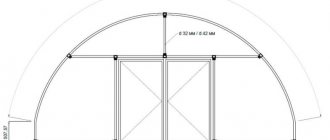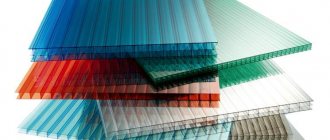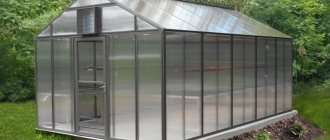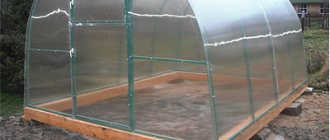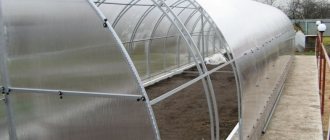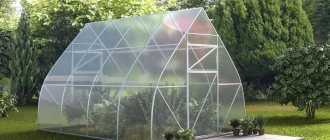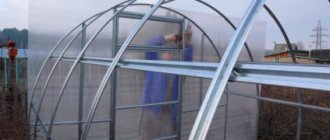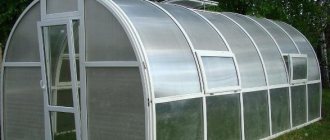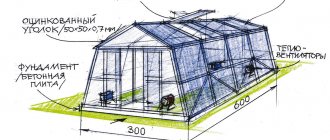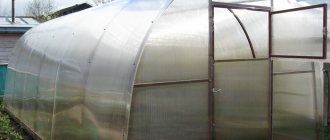Many residents of country cottages prefer to set aside part of their land for a vegetable garden or garden. To increase the efficiency of growing cultivated plants, greenhouses are installed in the yard. Recently, greenhouses made of polycarbonate are increasingly being built. They retain the desired temperature and humidity well, are quickly erected, and, which is important for private households, look very aesthetically pleasing.
Polycarbonate greenhouse on site Source vi.decorexpro.com
Some important parameters
Like any other engineering structure, such a greenhouse has both strengths and weaknesses. Its obvious advantages include the following characteristics:
- Light weight.
- Effective thermal insulation.
- Transparency sufficient for complete photosynthesis and crop ripening.
- Resistance to climate damage.
- Harmless to humans and plants.
- Possibility of scaling.
- Elementary installation.
Due to the fact that polycarbonate sheets can have different prices, depending on the quality, in some cases it becomes possible to significantly save on the material. The second option to save money is to select thinner sheets of polymer.
Polycarbonate also has an obvious drawback. It consists of vulnerability to exposure to sharp objects. That is why, in order to preserve the aesthetic qualities of the greenhouse, you should use pruners, knives and a sharpened hoe in it as carefully as possible.
What to cover with?
The materials used to cover the greenhouse are mainly film and glass. The glass can be either ordinary window glass, 4 mm, or special glass - greenhouse glass. A special feature of greenhouse glass is its high consumer properties. The cost of greenhouse glass is slightly higher than window glass. Glass must be cleared of snow in winter.
Film is a more economical option than glass, but lasts no more than two years. You should choose a film with a thickness of at least 1 mm. Reinforced film will, of course, last longer, although it is more expensive.
Greenhouse size 2 by 3
The 2x3 greenhouse structure is a compact garden building with a polycarbonate top and has the following characteristics:
- Length - 3 m;
- Width - 2 m;
- Height - 1.9 m;
- The frame is galvanized rectangular steel with a wall thickness of 1.2 mm;
- Fixation is carried out using steel fasteners.
What is polycarbonate
There are two types of polycarbonate - cellular and monolithic. For roofing work, as well as for the construction of auxiliary buildings on the site, including gazebos and greenhouses, the cellular version is mainly used. This is a transparent, flexible sheet material consisting of three layers:
- Upper layer . It is a sheet of polycarbonate, which is covered on top with a protective film that does not allow sunlight to destroy the material.
- The middle layer is a cellular layer. Hollow cells with polycarbonate walls give the material high thermal insulation characteristics and also make it lightweight. The walls of the cells act as a kind of stiffening ribs, due to which the material is characterized by quite high strength.
- The bottom layer is another solid sheet of polycarbonate, but without a protective coating.
Transparent polycarbonate for greenhouse Source eddi.ru
Greenhouse size 3 by 4
These are the best greenhouse sizes for a summer cottage with small garden plots. For the convenience of the vegetable grower, the greenhouse has two doors and two windows.
The parameters of this structure are as follows:
- 3 m wide;
- 2.1 m high;
- 4 m long.
Optimal width and length of the greenhouse
The size of the greenhouse must correspond to the area of the site and its purpose. It should be taken into account that it should not be covered with shadow from other objects, and next to it you need to leave space for open beds. Experienced gardeners recommend the following greenhouse sizes:
- wall height – from 160 cm;
- width – from 235 cm;
- length – from 6 meters (corresponding to the length of the polycarbonate sheet).
It should be taken into account that with a wall height of 160 cm, the ridge will be located much higher. The minimum width is calculated for two beds and a passage between them. If you have the desire and opportunity to have a greenhouse with several beds, you can make it wider. So, each additional bed will take another 1 meter + 35 cm per passage.
The length of the greenhouse can be quite large, but it is advisable to plan it as a multiple of 6 meters - along the length of the sheet of material. The best option is to build an elongated shape into two beds with a walkway. The more plants you plan to grow, the longer the greenhouse and the beds in it should be. However, if it is impossible to allocate a long, elongated section of the yard for the structure, you can build a square or even round greenhouse.
Compact square greenhouse Source mojateplica.ru
Greenhouse size 3 by 6
Garden greenhouses of the specified dimensions are erected on arched structures. The resulting configuration provides the structure with good aerodynamics, increased resistance to deformation and favorable aesthetics.
This model has the following parameters:
- Width - 3 m;
- Length - 6 m;
- Height - 2 m;
- Iron frame 0.7 mm thick;
- Two doors and vents for ventilation.
Tips for setting up greenhouses
- Paths in a greenhouse can be made from wooden boards, and they are treated with special disinfectants, otherwise they themselves will become a source of diseases and pests.
- Use light, portable, wide boards-paths to avoid walking on the soil in the greenhouse, not to compact the soil, and thus the plants will develop better.
- It is better to change the soil in the greenhouse every season mainly with a spade bayonet. This will give an increase in the harvest.
- When planting greenhouse plants, it is good to use compost or manure (for example, horse manure, with a small amount of straw); you can use humus peat.
- Alternatively, you can lay a layer of fresh green grass at the bottom of the ridge. The grass, like manure, will gradually burn out, releasing both the necessary nutrients and heat.
The most suitable greenhouse dimensions
It is generally accepted that at the dacha it is best to install a greenhouse structure made of polycarbonate, the dimensions of which are 6x3.
Despite its considerable dimensions, such a structure made of sheet building materials compares favorably with its analogues in terms of convenience and economic efficiency.
No. 1. Determining the main tasks of the greenhouse
Surely, everyone who is looking for a greenhouse understands why he needs it and for what purposes it will be used. However, before you begin to understand the advantages and disadvantages of different materials and shapes, it is necessary to very clearly outline the tasks assigned to the greenhouse. For some summer residents, it will be enough for it to look nice and look good on the site. Those who consider the structure as the basis for a business or as a help in the household, although they will pay attention to the appearance of the structure, will not focus on it when choosing a greenhouse.
Typically, greenhouses are built to grow vegetables and berries for their own consumption, but some summer residents plan to make a business out of this in the future. If in the first case the financial investments will not be so significant, then in the second they will become a serious investment, the size of which will largely determine the maintenance costs.
Another question that requires a clear answer is the type of greenhouse model: collapsible or stationary . If you are at your dacha all year round and are not afraid that in your absence someone may damage or even steal the structure (and this happens), it is better to choose a stationary model - it is less hassle. A collapsible greenhouse is an ideal option for those who visit their dacha only in warm weather; it will have to be assembled and disassembled twice a year.
The choice of certain greenhouse parameters also depends on what plants will be grown , because each crop has its own requirements for light and humidity levels. The height of the greenhouse also depends on the characteristics of the plants. For example, for tomatoes and other tall crops it is better to choose a rectangular structure.
Greenhouse dimensions 3x6
- it is completely suitable for growing vegetables in commercial quantities;
- the structure remains effective no matter how much the air temperature outside the greenhouse drops;
- The metal frame ensures tight fixation of all components, while the polymer sheets do not tear even under strong tension.
Foundation
It is advisable to install the greenhouse on a foundation, despite the fact that its weight will not exceed 200 kg, and the risk of subsidence on the ground under its own weight is minimal. The fact is that, firstly, in winter, precipitation settling on the walls of the greenhouse will significantly increase its weight. In addition, if it stands without a foundation, then cold air from the street can penetrate through the gap between the soil and the walls. There are known cases when during the summer the air temperature dropped below zero at night. In a greenhouse standing on “bare” soil, all the plants can die in one night.
Another reason to make a simple foundation is that it will provide good protection from the penetration of weeds and harmful insects. And for high-quality fixation of the frame, it is also needed.
Features of the greenhouse
- do not require daily careful maintenance;
- withstands long periods of cold weather and extreme heat (in the temperature range from - 50 to + 60);
- easy to transport when disassembled;
- sold at an affordable price;
- allow the use of a two-layer cover, which allows for reliable thermal insulation of the structure;
- easy to assemble, for which a simple tool is sufficient.
Extended greenhouse option
Popular greenhouse sizes are also the variety with sides of 3 and 8 meters. In addition to the above parameters, it has the following characteristics:
- Height - 2 m;
- Galvanizing of frame parts;
- The distance between the arches is 65 cm;
- The structure does not need painting.
This design provides for the presence of two doors and windows, the use of various types of fittings and fastening components.
What to consider when choosing the right greenhouse
Before you decide to build a greenhouse, you must answer the following questions:
- do you have space to place a greenhouse;
- is it possible to install it from east to west or from north to south (for southern regions);
- how much time and money will it take to prepare the soil for installing a greenhouse;
- will it be possible to avoid installing a greenhouse at the bottom of the slope;
- will it be possible to install the greenhouse at a distance from houses and trees so that their shadow does not cover it;
- how close are sources of water and electricity.
Selection of materials
When choosing a polycarbonate sheet, you should focus on two important parameters - its color and thickness. A thin sheet will not fit the metal frame as smoothly as a thick one, so for connoisseurs of graceful forms it makes sense to choose a thicker shell. The best solution in this case is a two-layer coating of the greenhouse frame.
The need for a foundation for a greenhouse structure is determined by its volume. If the owner’s choice fell on a low greenhouse, reminiscent of a bread box, then it can be installed without a base.
If you decide to install a high greenhouse on the site, then you will need wood or brick as the material for the foundation.
Frame
In order for the structure to last as long as possible, you need to choose the right material for the frame that will hold the walls of the greenhouse. The most economical option is a wooden frame. If the wood is treated with a special protective antiseptic before installation, its service life will be at least 10 years.
A frame made of a metal profile will be more reliable, but also more expensive. This is the option used by manufacturing companies. A metal frame will last longer than a wooden one, and it is much more convenient to assemble.
Dimensions and polymer thickness
It is believed that cellular polycarbonate is the best for greenhouses. This polymer has a hollow structure, which significantly reduces the load on supporting structures. The size of a polycarbonate sheet for greenhouses is determined by its thickness.
In order to prevent excessive scraps when cutting polycarbonate sheets, the following considerations must be taken into account:
- The length of the frame arches can be three, four, six, twelve meters;
- The flexibility of the selected sheet affects how it will fit the frame elements. Accordingly, when purchasing thick polycarbonate, it is necessary to provide some extra length, which is unlikely to be needed for a sheet of small thickness.
Which polycarbonate to choose
The main characteristics for a greenhouse are good light transmission, reliable heat retention and strength. To obtain a structure with optimal performance, polycarbonate sheets with a thickness of 4 to 10 mm should be used.
The thinner the material, the more expensive and heavier it is. Some conscientious manufacturers use polycarbonate of different thicknesses to create one design. Thus, arched elements are subject to more severe loads during strong winds and precipitation, so they are made of thicker material. Straight and side walls can be constructed from thinner polycarbonate.
Polycarbonate sheets are available in a standard width of 210 cm. Sheets can be 6 or 12 meters long. These parameters are taken into account when drawing up a drawing of the future greenhouse.
Drawing of an arched polycarbonate greenhouse Source stroymoda-nk.ru
It is worth noting that the quality of the finished greenhouse directly depends on the characteristics of the polycarbonate. At the same time, there is a large amount of counterfeit material on the market today that does not have the declared properties. This means that you should purchase finished construction or material for it only from reliable suppliers with extensive experience and an impeccable reputation.
